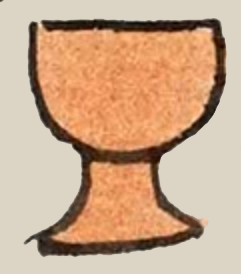tecomatl (Mdz40r)
This element has been carved from the compound glyph for the place name for Cuauhtecomatlan. It is a simple, orange-clay or wooden colored, bowl-shaped cup with a pedestal or stem that is flared at the bottom.
Stephanie Wood
Our online Nahuatl Dictionary provides many examples of uses for this cup, including as a vessel for alcoholic beverages and for a thick hot chocolate beverage. Tecomates, as they came to be called in Mexican Spanish, were regular items found in alphabetic, Nahuatl-language testaments, and therefore considered valuable parts of a person's estate that were worth passing on to the next generation.
James Lockhart noted a possible connection between the cuezcomatl and the comitl (ceramic jug). One can also see a phonetic relationship between the cuezcomatl and the tecomatl (wooden or ceramic cup).
Stephanie Wood
c. 1541, or by 1553 at the latest
Stephanie Wood
Crystal Boulton-Scott made the SVG.
cups, vessels, tazas, copas, vasos

tecoma(tl), cup, https://nahuatl.wired-humanities.org/content/tecomatl
clay vessel, ceramic cup
el tecomate, vaso de barro
Stephanie Wood
Codex Mendoza, folio 40 recto, https://digital.bodleian.ox.ac.uk/objects/2fea788e-2aa2-4f08-b6d9-648c00..., image 90 of 188.
The Bodleian Libraries, University of Oxford, hold the original manuscript, the MS. Arch. Selden. A. 1. This image is published here under the UK Creative Commons, “Attribution-NonCommercial-ShareAlike 3.0 License” (CC-BY-NC-SA 3.0).


